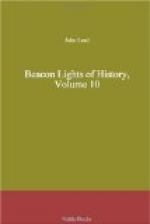kaleidoscope of oratory,—they place the
familiar ones in new positions, and produce new pictures
ad infinitum. Sometimes a genius, urged
by a great impulse, may dash out in an untried course
of thought; but this is not always a safe venture,—the
next effort of the kind may prove a failure.
No man can be sure of himself or his ground without
previous and patient labor, except in reply to an antagonist
and when familiar with his subject. That was
the power of Fox and Pitt. What gave charm to
the speeches of Peel and Gladstone in their prime was
the new matter they introduced before debate began;
and this was the result of laborious study. To
attack such matter with wit and sarcasm is one thing;
to originate it is quite another. Anybody can
criticise the most beautiful picture or the grandest
structure, but to paint the one or erect the other,—
hic
labor, hoc opus est. One of the grandest
speeches ever made, for freshness and force, was Daniel
Webster’s reply to Hayne; but the peroration
was written and committed to memory, while the substance
of it had been in his thoughts for half a winter, and
his mind was familiar with the general subject.
The great orator is necessarily an artist as much
as Pascal was in his
Pensees; and his fame
will rest perhaps more on his art than on his matter,—since
the art is inimitable and peculiar, while the matter
is subject to the conditions of future, unknown, progressive
knowledge. Probably the most effective speech
of modern times was the short address of Abraham Lincoln
at Gettysburg; but this was simply the expression of
the gathered forces of his whole political life.
In the month of July, 1837, Mr. Gladstone was married
to Miss Catherine Glyn, daughter of Sir Stephen Richard
Glyn, of Hawarden Castle, in Flintshire, Wales,—a
marriage which proved eminently happy. Eight
children have been the result of this union, of whom
but one has died; all the others have “turned
out well,” as the saying is, though no one has
reached distinguished eminence. It would seem
that Mr. Gladstone, occupying for forty years so superb
a social and public station, has not been ambitious
for the worldly advancement of his children, nor has
he been stained by nepotism in pushing on their fortunes.
The eldest son was a member of Parliament; the second
became a clergyman; and the eldest daughter married
a clergyman in a prominent position as headmaster
of Wellington College.
It would be difficult to say when the welfare of the
Church and the triumph of theological truth have not
received a great share of Mr. Gladstone’s thoughts
and labors. At an early period of his parliamentary
career he wrote an elaborate treatise on the “State
in its relation to the Church.” It is said
that Sir Robert. Peel threw the book down on the
floor, exclaiming that it was a pity so able a man
should jeopardize his political future by writing
such trash; but it was of sufficient importance to
furnish Macaulay a subject for one of his most careful




